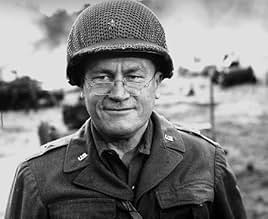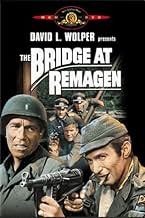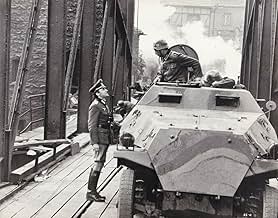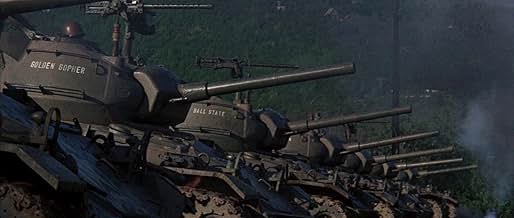CALIFICACIÓN DE IMDb
6.7/10
11 k
TU CALIFICACIÓN
Cuando los ejércitos aliados se acercan, los alemanes deciden volar el último puente sobre el Rin, atrapando a sus propios hombres en el lado equivocado. ¿Pero sucederá?Cuando los ejércitos aliados se acercan, los alemanes deciden volar el último puente sobre el Rin, atrapando a sus propios hombres en el lado equivocado. ¿Pero sucederá?Cuando los ejércitos aliados se acercan, los alemanes deciden volar el último puente sobre el Rin, atrapando a sus propios hombres en el lado equivocado. ¿Pero sucederá?
- Dirección
- Guionistas
- Elenco
Peter van Eyck
- Gen. Von Brock
- (as Peter Van Eyck)
Anna Gaël
- French Girl
- (as Anna Gael)
Vít Olmer
- Lt. Zimring
- (as Vit Olmer)
- Dirección
- Guionistas
- Todo el elenco y el equipo
- Producción, taquilla y más en IMDbPro
Opiniones destacadas
I especially like the performance of Robert Vaughn in this film, as the German officer in charge of the blowing up of the Remagen bridge. His last line, in front of the firing squad, is one of the most memorable I know in the history of war films and it is all the more poignant for its juxtaposition immediately after the scene showing the emotional reunion of the characters played by George Segal and Ben Gazzara. Elmer Bernstein's memorable theme music also adds to ones enjoyment of this film although, much to my surprise, I gather that the film soundtrack has never been released in this country.
This has to be one of the best war movies made in the 1960s, an era when all too often filmmakers went overboard in glorifying war while glossing over its horrors and populating their movies with larger-than-life hero characters who could have come straight out of a boys' comic. This movie doesn't fall into that trap. The characters - both German and American - are believable, and the movie sets and the equipment used (with the glaring exception of Korean War era American tanks) are authentic for the period. With so many WWII Sherman tanks and other vehicles still in museums, private collections and (at least back in the 60s) still in use in large numbers in the armies of several smaller countries, it has always been a puzzle to me as to why so many moviemakers took the simple option and used anachronistic military hardware in WWII movies, presumably assuming that the average moviegoer wouldn't even notice or wouldn't care. The most horrible example of this is the 1965 movie "Battle Of The Bulge". But I digress. Ignoring the tank factor, "The Bridge At Remagen" is a great movie. The best performance among many strong ones in this film has to be that of Ben Gazzara as Sergeant "Angel" Angelo, and the scene in which he kills the German sniper is extremely strong, moving stuff. Highly recommended.
Very under rated war epic. Why this movie isn't just as big as the other big war movies of the 60's(the guns of Navarro /bridge to far) is probably because it was to realistic for the times! acting is good only problem is that the Germans speak a little bit to good English but the action is topnotch especially the big tank battle scene in the middle of the movie, is one of the best war scenes i've ever seen till this day!!!The Bridge scene is also very impressive with tanks that destroy huge apartment blocks! this was a big budget movie at the time you can tell you can't count the extra's walking around and the destruction is as realistic as I've ever seen !!TRULY A MUST SEE FOR WAR MOVIE LOVERS!!!
Famous for its Apocalypse Now-style production problems. Filmed in then-Czechoslovakia where the then Communist government offered up a whole town (due to be cleared to make way for a strip mine) for cinematic destruction. But halfway through shooting the Russian army invaded to remove reformist president Alexander Dubcek. George Segal and Robert Vaughn give career best performances, but it also marks the moment when US war films moved beyond action-adventure and into a darker realm. The capture of the Remagen Bridge in 1945 was a magnificent feat of arms by the US Army. But in the film account the troops are slovenly, often fearful thugs, slanging and striking their officers, robbing corpses and killing children. It's not really about World War II at all, but about how many Americans saw the Vietnam War. The Bridge at Remagen is out of time, set in 1945 but made in 1968, the year of the Tet Offensive, when the US realised that Vietnam was a lost war. It shows.
This is a no-nonsense, gritty, thoroughly well made war film. As a recreation of war it is quite convincing, I couldn't spot anything wrong with the military equipment. The battle scenes are exciting and give a good, clear picture of the fighting instead of just chaotic shots of shooting and explosions. However, the people are never lost among the warfare. These are complex, solid characters, and the actors are good throughout. There is nothing superhuman, just individuals, very low on humanity or manners. Tired and ill-motivated Americans, desperate and scared Germans. Nothing glorious or patriotic: there is even a scene with American planes bombing refugees and Germans trying to protect them! This is not an adventure, more a depiction of an interesting situation and the people in it. However, the story flows on and there isn't a dull moment. Why this film hasn't acquired more recognition is beyond me. As a war film I think it is better than most of it's contemporaries, like "The Battle of the Bulge" or "Anzio".
¿Sabías que…?
- TriviaFilming in Czechoslovakia was interrupted by the Soviet invasion of August 1968. Cast and crew were taken to safety in a convoy of 28 taxis, except for Robert Logan, who stayed behind with film gear in order to capture the invasion on film and photo. According to the book "Bill Collins Presents The Golden Years of Hollywood", a half-replica of the bridge was built near Castelgandolfo, the Pope's summer residence south of Rome, and the film was completed in Hamburg (Germany) and various Italian locations. In 2007, BBC Radio aired "Solo Behind The Iron Curtain" a drama based on the invasion, starring Robert Vaughn as himself.
- ErroresAs the bridge comes under fire, there is a German train approaching the bridge from one side as American tanks approach from the other. The American tanks open fire on the train and it explodes. However, the train then comes to an immediate halt. Real trains have an immense amount of momentum and require a considerable distance to come to a complete stop. The train we see explode is undoubtedly a scale model, but it should have been allowed to continue moving forward after having been hit.
- Citas
[Kreuger is offered a last cigarette before he is executed by firing squad. He and the Nazi Officer hear planes]
Major Paul Kreuger: Ours or theirs?
Nazi Officer: Enemy planes, sir.
Major Paul Kreuger: But who is the enemy?
- ConexionesFeatured in An Officer and a Movie: Bridge at Remagen (2011)
Selecciones populares
Inicia sesión para calificar y agrega a la lista de videos para obtener recomendaciones personalizadas
- How long is The Bridge at Remagen?Con tecnología de Alexa
Detalles
Contribuir a esta página
Sugiere una edición o agrega el contenido que falta

Principales brechas de datos
What is the French language plot outline for El puente de Remagen (1969)?
Responda





































